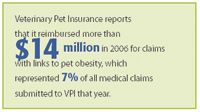Pets keep getting fatter
The numbers prove that obesity is a serious problem.
The numbers don't lie. Breed standard weights—the acceptable weight ranges for a particular breed—are shifting, according to the National Pet Obesity Awareness Day Study, conducted by the Association for Pet Obesity Prevention (AFPOP) in October 2007. The average weight for the top 10 most popular breeds recognized by the American Kennel Club has increased by at least 1 pound with no marked increase in the pet's length. The study also showed that 45 percent of participating dogs and 53 percent of participating cats were overweight or obese. And many clients know their pets are portly: Sixty-six percent of cat owners and 53 percent of dog owners identified their pet as overweight.

The study also revealed that many team members weren't accurately scoring pets' body conditions based on pets' measurements, says Gina Toman, a veterinary assistant at Seaside Animal Care in Calabash, N.C., who assisted with the study. Based on breed standards and pets' body dimensions, 10 percent of participating dogs and 13 percent of participating cats were assigned a body condition score (BCS) 3 when the animals more accurately fit the criteria for a BCS 4 or 5, says Toman, a Firstline Editorial Advisory Board member. She encourages all team members to learn more about obesity and weight management, including how to classify pets' body condition and understanding the risks associated with obesity. The AFPOP offers criteria to help distinguish body condition scores at www.petobesityprevention.com.

The cost of obesity

Clients want to know

Average weights